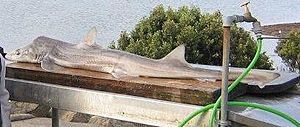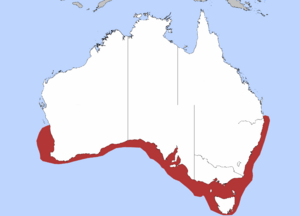Gummy shark facts for kids
Quick facts for kids Gummy shark |
|
|---|---|
 |
|
| Gummy shark caught in Hastings, Western Port, Victoria | |
| Conservation status | |
| Scientific classification | |
 |
|
| Common distribution for flake in southern Australia | |
| Synonyms | |
|
The gummy shark (Mustelus antarcticus) is a type of shark found mostly in the southern waters of Australia. It is also known by other names like Australian smooth hound or flake. These sharks are usually small to medium-sized. They live near the bottom of the ocean. People often fish for gummy sharks because they taste good and are popular to eat.
Some scientists believe that another shark, the Mustelus walkeri (eastern spotted gummy shark), is actually the same species as the gummy shark. It might just be a different group of the same animal.
Contents
What Gummy Sharks Look Like
The gummy shark has a slim body. Its back is a darker grey with white spots, and its belly is a shiny silver-white. It gets its name "gummy" from its unique teeth. Instead of sharp, pointy teeth, it has flat, plate-like teeth. These teeth are perfect for crushing the shells of its prey.
Male gummy sharks can grow up to about 157 centimeters (about 5 feet 2 inches) long. Females can be a bit larger, reaching up to 175 centimeters (about 5 feet 9 inches). When they are born, these sharks are much smaller, usually between 30 and 35 centimeters (about 12 to 14 inches) long.
Hunting and Ocean Home
Gummy sharks eat many different things. Their diet includes crustaceans like crabs, marine worms, small fish, and cephalopods such as octopus, squid, and cuttlefish. Their special plate-like teeth help them crush the hard shells and bodies of their prey.
These sharks spend most of their time on or near the ocean floor. How far they travel depends on their age. Young gummy sharks do not travel as much as adult sharks. Female sharks tend to travel longer distances than males. Gummy sharks prefer sandy areas on the seabed. They often come closer to the shore at night to hunt for food.
Where Gummy Sharks Live
Gummy sharks are mostly found along the southern coast of Australia. This includes places like Bunbury, Tasmania, and the Bass Strait. They also live in coastal parts of the Pacific Ocean, like near Japan, and in coastal areas of the Indian Ocean. They can be found from the surface down to about 350 meters (1,150 feet) deep in waters that are not too cold or too warm.
Gummy Shark Reproduction and Life Cycle
Gummy sharks reproduce in a special way called ovoviviparous. This means the mother shark produces eggs, but the eggs hatch inside her body. The pups then develop inside the mother until they are ready to be born live. A seahorse is another animal that reproduces this way.
Gummy sharks usually mate and ovulate (release eggs) over about three months, from November to February. The babies then grow inside the mother for about eleven to twelve months. When born, the baby sharks are usually 30 to 36 centimeters long.
Pregnant gummy sharks look for safe, shallow areas near the coast, like bays, to have their pups. These are called nursery areas. A female gummy shark can have many pups in one litter, sometimes up to 57! However, the average number of pups is around 14. Females are ready to have babies when they are about five years old. Male sharks can reproduce when they are about four years old. Gummy sharks typically live for about 16 years.
Predators and Human Interaction
Gummy sharks are not known to be a danger to people swimming or fishing. Since they live on the ocean floor, they do not often come into contact with humans. They also tend to swim away if they see people, which makes them hard to study.
Gummy sharks have two main predators. One is humans, who catch them for food and sport. The other main predator is the broadnose sevengill shark. These larger sharks often hunt young gummy sharks that stay in shallow waters.
Fishing for Gummy Sharks
Gummy sharks are a very popular fish for people to eat. Their meat is often sold as "flake" in southern Australia. Because their fillets are boneless, they are a favorite choice for the fish and chips industry across Australia.
Even though gummy sharks are popular, they are not currently being overfished. They often live in the same areas as school sharks, which have fishing limits to protect their numbers. This means that fishers targeting gummy sharks must be careful not to harm the school shark population.
The number of gummy sharks between three and seven years old has decreased a little due to new fishing methods. However, younger gummy sharks (around two years old) are not affected as much. The IUCN Red List, which tracks how endangered different species are, lists the gummy shark as "least concern" (LC). This means they are not currently at risk of extinction.
To learn more about gummy sharks, about 100 of them in Western Australia have been tagged with special devices. These tags help scientists understand how the sharks migrate and travel.
In Victoria, there are rules for recreational fishers about how many sharks they can catch. These are called "bag limits." For gummy sharks and school sharks, fishers can usually catch and keep two sharks. For larger boats, the limit is five sharks. If a gummy shark is caught and it is smaller than 75 centimeters (about 2.5 feet), it must be released back into the water.
See also
 In Spanish: Musola suave para niños
In Spanish: Musola suave para niños


